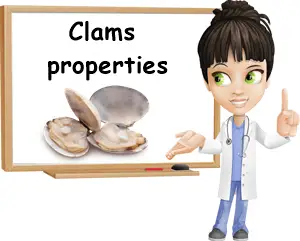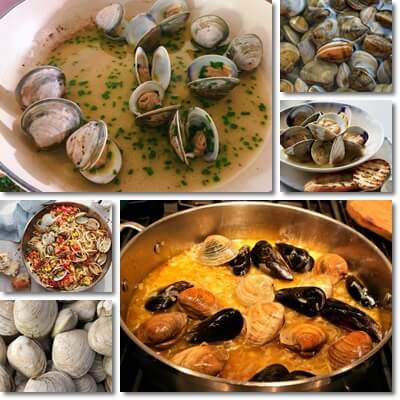Clams are bivalve mollusks that live in both saltwater and freshwater. They feed by filtering water and extracting nutrients and microorganisms for food, similar to mussels, oysters and scallops. Clams as seafood provide important amounts of non heme iron, vitamin B12, healthy Omega 3 fatty acids and protein. They are low in fat and cholesterol and have a moderately low caloric value. Compared to other mollusks, clams are reportedly low in contaminants, although consumption of raw clams can cause food poisoning. Clam meat is a great brain food to combat mental fatigue and brain fog, provides anti-inflammatory benefits and elevated energy levels.
What do clams look like? There are a great number of edible saltwater and freshwater clam species. The typical edible clam has a symmetrical shell made up of two parts joined together at one end by a ligament. Clam shells are usually rounder in shape with a pointier and bumpier edge where the two parts of the shell are hinged. Color varies from species to species. Some species are cream-colored with yellow, brown or gray. Other species are off-white with purple-grayish edges. Most shells have concentric or radiating line patterns with different color combinations and patterns.

Razor clams are a distinct type of edible clams. They are elongated, oblong-shaped and may vary in size depending on the species. They get their name from their shell shape which resembles an old-fashioned razor and due to having sharp shell edges. Shells are often colored in brown, amber, yellow, gray or cream and have concentric lines. What part of the clam do you eat? Basically everything that is inside the shell of an edible clam species is edible. This includes: the meaty abductor muscle called the clam foot which helps the clam bury itself in mud or sand and the internal organs. Some people only eat the abductor muscle and discard the rest, others eat the entire clam.
What do clams taste like? Raw clams are usually eaten whole, meaning you eat both the muscle and other insides. The foot of the clam has a slightly chewy texture and a delicate seafood taste with pleasant fishy, briny and sweet flavors. The rest of the clam has a mushy texture with slight briny, fishy flavors. Larger clams are chewier in texture, while smaller, younger ones are more tender. What do razor clams taste like raw? Razor clams have a pleasant taste with subtle fishy, briny flavor notes and a delicate sweet aftertaste.
Cooked clams taste even better to some people and can be steamed, grilled, boiled, baked, fried or made into soup. Similarly, either the foot of the clam alone or all the insides may be eaten. Overcooked clams become rubbery and may taste like leather. Typically, they require very little cooking. It is recommended to cook clams only until their shells start opening, but remove them from the stove before they open completely so they don’t overcook. Clams that do no open during cooking are best discarded.

Clam chowder is a popular dish made with clams as the main ingredients and thickened with other vegetables, crackers, milk or cream. There are many variations of clam chowder including Manhattan clam chowder (with a tomato broth) and New England clam chowder (thickened with milk or cream). What to pair clams with? Clams may be eaten with lemon juice, extravirgin olive oil, melted butter, garlic powder, freshly chopped parsley, other shellfish like mussels, scallops or oysters.
How to open clams? Clams should be left to soak in water with salt for several hours before eating them to remove any sand that may have accumulated inside the shell, then brushed. Refrigerate them for an hour to make them easier to open. Firmly hold the clam in your hand with the hinge towards the base of your thumb and slide a thin knife between the top and bottom shell. Cut through until you reach the hinge, then open the shells and detach the insides with the knife. Place a bowl beneath to catch any liquid and use a kitchen towel or rubber gloves to protect your hand.
Nutrition facts and health benefits
What are the benefits of eating clams? Raw, cooked and canned clams hold many benefits as a result of their excellent nutritional value. Here are the top 4 nutrition facts and health benefits of clams:
1) Rich in protein for building muscle. 100 g of clams contains approximately 25 g of protein, which represents 50% of the recommended intake for the average person eating a 2,000 kcal diet. In other words, clams are one of the best sources of protein to include in your diet. Protein is vital for building muscle and repairing damaged muscle fibers.
Moreover, the amino acids that make up protein have benefits for the brain, helping synthesize neurotransmitters that regulate mood, sleep and appetite. Meeting your daily requirements of protein means clearer thinking, reduced brain fog, better mood, more restful sleep and enhanced productivity. Also, because they are low in fat and have around 150 kcal/100 g, clams are good for weight loss.
2) Great source of vitamin B12 for brain health. Compare the numbers below:
– 100 g of cooked clams has around 99 micrograms of vitamin B12
– Vitamin B12 RDI (recommended daily intake) is 2.4 micrograms
This means 100 g of clams provides 41 X the RDI of vitamin B12.
Clams excellent vitamin B12 content recommends them as a great brain food, ideal for preserving mental health and cognitive functions. Vitamin B12 helps maintain nerve cell integrity by preserving the myelin sheath protecting the tail of neurons. It is suspected to contribute to lower risks of Alzheimer’s, Parkinson’s, multiple sclerosis and other degenerative diseases of the nervous system. Moreover, the vitamin helps produce red blood cells and contributes to combating anemia and elevating energy levels.
3) Provides healthy Omega-3 fatty acids. Omega 3 is a healthy fat in clams and other shellfish, fish and fish oils. It has strong antioxidant and anti-inflammatory benefits and helps lower bad LDL cholesterol and raise good HDL cholesterol, preventing the formation of plaques inside the artery walls. This contributes to lowering high blood pressure and preventing cardiovascular events such as stroke. Omega 3 fatty acids are good for the skin, hair and eyes.
4) Important source of iron. Clams can be an important source of dietary iron, providing up to 150% of the recommended daily intake of the mineral. On average, 100 g of clams has 28 mg of iron out of the 18 mg RDI (recommended daily intake). Iron is needed to produce red blood cells and ensure proper oxygenation of muscles and tissues, contributing to high energy levels and a general state of physical and mental well-being. A deficiency causes anemia, low energy levels and fatigue.
However, iron content may vary. For example, drained solids from canned clams have less iron because part of it remains in the liquid. Some studies declare the iron in clams has poor bioavailability and is thus not well absorbed (Evaluation of clams as a food source of iron: Total iron, heme iron, aluminum, and in vitro iron bioavailability in live and processed clams). Vitamin C can help boost iron availability from clams and maximize absorption.
Below is an beautiful video depicting clams coming out of the sand at the beach followed by the tide coming and covering them.
Side effects and health risks
The health risks associated with eating clams include:
1) Allergy and anaphylactic shock. If you are allergic to clams or other shellfish, crustaceans or fish, avoid eating them. If you experience allergy symptoms like tingling tongue, rash on skin, itchiness, nausea, vomiting, sudden drop in blood pressure, dizziness, fainting sensation, difficulty breathing and swelling of the tongue, seek medical help immediately. Allergic reactions can culminate with anaphylactic shock.
2) Food poisoning. Clams that have gone bad or are contaminated with various bacteria can cause food poisoning. Nausea, vomiting, abdominal pain and diarrhea are classic signs and warrant a visit to the doctor’s office as soon as possible. All shellfish can be carriers of E coli, Salmonella and intestinal parasites and are most dangerous for children, the elderly and those with a compromised immune system.
3) Contaminants. Although clams are reportedly lowest in contaminants compared to other shellfish, they are still filter feeders, meaning the filter water and thus can accumulate methylmercury, aluminum and toxins from water and marine algae that damage the nervous system. Make sure you get your shellfish from reputable fish markets whose activity is in accordance with sanitary laws.
